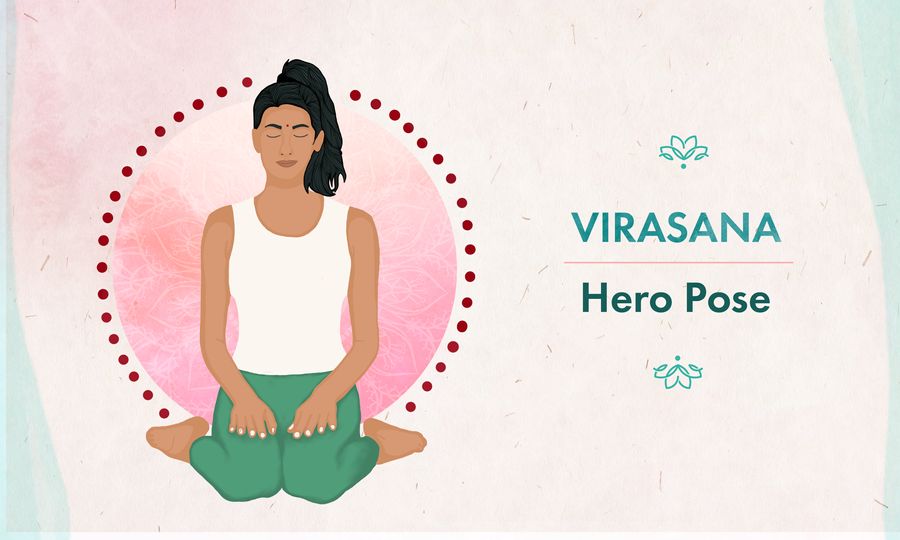Hero Pose, or Virasana in Sanskrit, is a kneeling posture in yoga where the buttocks rest on the floor between the feet. Often practiced in meditation, this pose might look relatively simple and even relaxing. However, it’s a bit more challenging than it looks.
If you're someone with tight knees or thighs, Virasana can be tough. For beginners, practicing Hero Pose will feel uncomfortable and might be impossible for some to fully come into the pose, leading to strain or injury if pushed too far. But when approached with the right techniques and modifications, Hero Pose can be an incredibly beneficial and rewarding part of your yoga practice.
In this simple guide, we'll explore what Hero Pose is, its benefits, and why it might be so challenging for some. Most importantly, I'll share tips on how to practice Virasana safely, with variations for all levels.
What Is Hero Pose (Virasana)?
Hero Pose is a traditional seated yoga pose commonly practiced in Ashtanga Yoga, or as an alternative to Lotus Pose in meditation and Pranayama. From the Sanskrit word Virasana, Vira meaning “power, strength, or hero” and asana meaning “pose”, Hero Pose in yoga has become symbolic for humble devotion and service to a higher power.
In this seated asana, you kneel down and then sit back, allowing your buttocks to rest comfortably between your feet which are placed on either side. The spine is strong and erect, creating a natural alignment that extends from the tailbone to the crown of the head. As a result, yoga’s Hero Pose provides a blend of gentle stretching and grounding. It opens up the thighs and hips while also encouraging a more centered and calmer state of mind.
Read: Differences Between Vajrasana and Virasana – Practicing Hero Pose and Diamond Pose
The Anatomy of Hero Pose in Yoga
Virasana primarily stretches the quadriceps, hips, and the front thigh muscles, which is especially beneficial for those with tight thighs or who sit for long periods of time. Beyond this, the pose helps align the spine and pelvis, promoting better posture. It also extends a gentle stretch to the abdomen, ankles, and knees, which can be great for knee pain relief.
There are clearly many benefits of practicing the hero posture; however, it’s essential that you take a mindful approach to the pose and understand the parts of your body that take more strain than usual, like the hips, knees, and ankles. Let’s take a closer look at the body's movements in Virasana.
Knees
In yoga's Hero Pose, the knees are pressed into extreme flexion, which may be unsafe for injured or sensitive knees. Even healthy knees may feel strained if they are not used to sitting in this kneeling position. However, if approached slowly (over weeks or months—not minutes), you can safely increase knee range of movement and improve overall knee joint health.
Ankles & Feet
As the feet are pressed flat against the ground, the ankles experience a stretch through plantar flexion, where the toes point away from the body. This position not only stretches the muscles along the front of the shins but also works on the intricate connective tissues within the ankle and foot joints. If you tend to experience stiffness or limited mobility in these areas, this posture can offer a beneficial stretch.
Discover: What is Fascia & Why Every Yoga Practitioner Should Know About It
Hips
In Hero Pose, the hips experience a combination of movements—they are pressed into internal rotation while in a flexed position. For some people, the restriction is in the soft tissues and their flexibility can be increased over time. This is often because the muscles and tissues around the hips are tight. But with regular and careful practice, these areas can become more flexible, giving you a better range of motion as time goes on.
Now, it's important to remember that everyone's anatomy is different. Sometimes, what limits you in a pose isn't just muscle tightness, but the actual shape of your hip bones. And bones, unlike muscles, won't change with stretching. This means that pushing too hard for more flexibility can be harmful. It’s also normal for one side of your body to be more flexible than the other. So, the key is to be aware of your own body's limits, practice yoga in a way that feels good and safe for you, and not to compare yourself with others or aim for a 'perfect' pose.
Also see: Hip Openers Unlocked: Guide to Strong & Tension-Free Hips
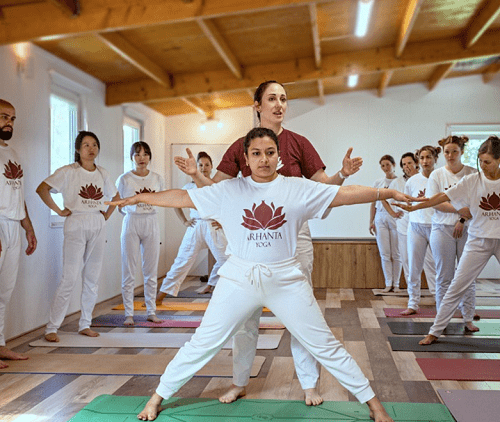
Experience authentic Hatha Yoga
Get free access to exclusive guided lessons with master teacher Kalyani Hauswirth-Jain
How to Do Hero Pose (Virasana)
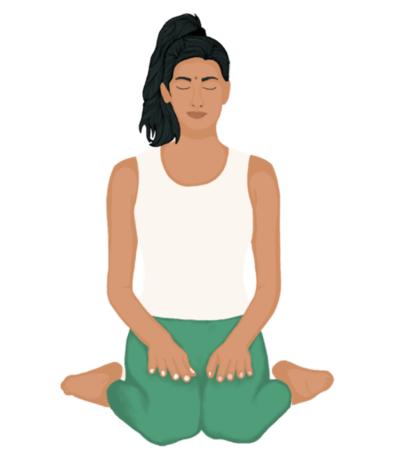
In Hero Pose, you get to stretch your hip joints, quads, and ankles. But remember to be kind to your knees. If you struggle with knee pain, use a support that is slightly higher than you think you need, like a cushion, yoga block, or a folded blanket. If you feel too much pressure on your knees, prop yourself up a bit more. The key is to be comfortable and let your body ease into the stretch.
When you’re ready, follow these simple steps to come into Hero Pose safely:
- Begin by kneeling upright on your yoga mat. Keep your knees together.
- Gently shift your feet apart, placing them slightly wider than your hips. Ensure the tops of your feet are flat against the floor.
- Slowly lower your buttocks down between your feet. Be mindful and move gently.
- If your buttocks comfortably reach the floor without any strain in your joints, sit up tall. Your weight should pass through your sit bones down to the floor.
- If your sit bones don’t reach the floor, or if you feel strain in your joints or muscles, use a modification. Sit on a block, cushion, or folded blanket for support.
- If comfortable, hold the pose for several deep breaths, up to a few minutes. Focus on maintaining a steady, relaxed breathing pattern.
- Always be mindful of how your body feels. If you experience any sharp pain or significant discomfort, gently exit the pose and rest.
Remember, the key to any yoga pose is to find a balance between effort and ease. Be patient with yourself, and enjoy the process of getting to know your body better. For beginners, take note of these tips when practicing Virasana.
Beginner Tips
- It's okay, even good, to feel a stretch. This means you're working on your flexibility.
- Any pain or uncomfortable strain means you've gone too far. Yoga shouldn't hurt.
- If you have any injuries, instability, or sensitivity in your joints, it's crucial to be extra careful. Use modifications and only progress gradually as your joints become stronger and used to the movements.
- If a pose doesn't feel right, check out the modifications below. There are always options and variations to suit your unique needs and abilities.
Hero Pose Variations & Modifications for All Levels
The most common modification for Hero Pose is to place a cushion between the feet, under the sit bones. This eases pressure on the knee flexion and internal hip rotation. Reduce ankle strain by placing a small, folded towel under each shin. This will change the leg position, so you may need to add a towel under the sit bones for balance.
There are a number of other Hero Pose variations that can either enhance or ease the difficulty of the pose. Let’s start with a beginner-friendly variation that is also a fantastic preparation pose for full Virasana.
Half Hero Pose (Ardha Virasana)
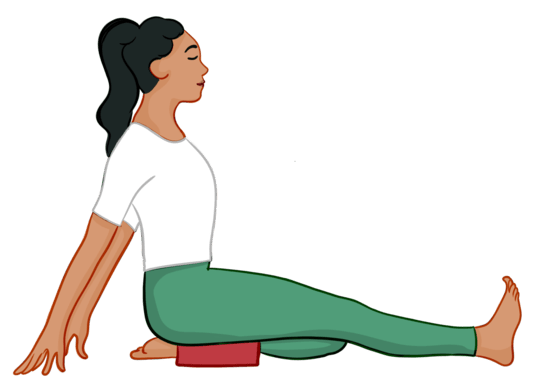
Half Hero Pose, or Ardha Virasana is the one-sided variation of Hero Pose. This posture is a great way to ease into the full Hero Pose, especially if you're new to yoga or have tight thighs and knees.
- Begin by kneeling on your yoga mat. Keep your spine straight and your knees together. This will be your starting point.
- Gently extend your right leg straight out in front of you. Keep your foot flexed and your leg active. This position requires some length in your hamstring, so if it feels tight, remember to breathe deeply and ease into the stretch.
- Keep your left leg in the kneeling position. The top of your left foot should rest on the floor, and your buttock should ideally rest on the floor. This creates a stretch in your left thigh and hip.
- Make sure your hips are square to the front of your mat. If the pose feels uncomfortable or puts too much pressure on your knee, you can sit on a block or cushion.
- With one leg extended and the other folded, hold the position for several deep breaths. Keep your spine elongated and your chest open.
- Gently release the pose and switch legs.
Reclining Hero Pose (Supta Virasana)
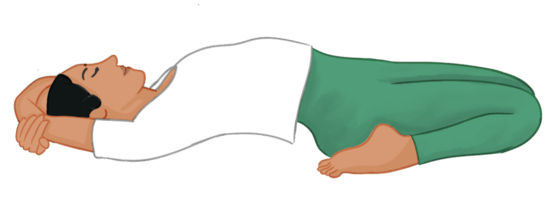
Reclining Hero Pose, also known as Saddle in Yin Yoga, is a restorative variation that helps stretch tight hip flexors and improve flexibility in the spine. It also mobilizes the sacroiliac joints—connection between the pelvis and lower spine—improving stability and functioning in the lower body.
As with Virasana, Supta Virasana should be approached carefully to avoid strain or injury. Follow the steps above to come into Hero Pose, then deepen the pose with the instructions below.
- To move into the reclined hero position, place your hands on the floor behind you and walk them backwards a little, resting your weight through your hands. If comfortable, you can lower your body and rest your weight through your elbows.
- If you are using a cushion under your sit bones, stay on your hands or on your elbows.
- If your buttocks are comfortably on the floor, you may try lying down and resting your upper back and head on the ground. Your lower back will be arched up from the ground.
- Bring your arms above your head and hold on to your opposite elbows.
- Breath evenly and relax in the pose for as long as comfortable.
- To come out of Reclining Hero Pose, carefully push yourself up onto your elbows. From there, push up onto your hands. Then, gently lift your buttocks to unwind one leg at a time.
Modifications
- As with Virasana, you can practice Supta Virasana with one leg straight out in front instead of having both legs folded. For additional balance in Half Reclining Hero Pose, place a pad under the shins. You can also use a cushion under the sit bones, just don’t try to lie all the way back to the floor.
- When reclined, the knees can be slightly apart instead of touching. The knees may lift off the floor a little, but only if it’s comfortable and pain-free (the lifted position reduces hip extension but increases stretch at the ankle).
- For a reclined resting height in between the elbows and the floor, use a cushion or bolster behind the upper back and head. This is also a good solution to take strain off the arms or shoulders if needed.
- Another alternative—to improve hip extension range needed in Reclined Hero Pose—is to practice Half Bow or Bow Pose. For this pose, you’ll lie on your stomach, catching one or both feet in hand behind the back.
Benefits of Hero Pose
Supports Healthy Spine Posture
Hero Pose is particularly beneficial for those who struggle to maintain an upright spine in meditation seated positions like Easy Crossed-Leg or Lotus Pose. This pose is easier on the hamstrings, allowing for a more comfortable upright posture and better spinal health.
Enhances Joint & Muscle Flexibility
Virasana plays a crucial role in increasing the flexibility of hips, knees, ankles, and feet. It effectively stretches the quadriceps muscles in the thighs and the tibialis anterior near the ankles. Hero Pose also gently works on the connective tissues around the hip joints, contributing to overall joint health. The degree of benefit can vary depending on individual body differences, but it generally improves flexibility and mobility.
Revitalizes Tired Legs
For those who spend much of their day standing or walking, Hero Pose offers a welcome relief. It relaxes and rejuvenates tired legs, while also grounding the body for meditation. The pose allows for a comfortable, upright position that can be maintained for longer periods, promoting relaxation and deeper focus in meditation practices.
Final Thought
Hero Pose might require a bit of tweaking to perfectly fit your body's needs, but that's the beauty of yoga—it's adaptable. With a little bit of care and maybe the help of a few cushions for extra support, you can make this pose uniquely yours. I encourage all my students to try Virasana, and who knows, you might find that it becomes a cherished part of your meditation or Yin Yoga routine.

Experience authentic Hatha Yoga
Get free access to exclusive guided lessons with master teacher Kalyani Hauswirth-Jain

